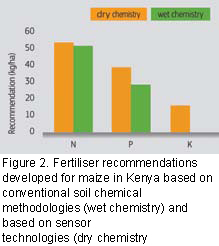Dr. Christy van Beek, senior soil scientist at SoilCares, shares her expertise on soil fertility and fertiliser recommendations in a series of blogs.She now shares her view on the applicability of sensor-based technologies for developing fertiliser recommendations in this new blog.
The soil mystery
Soil data is used to develop fertiliser recommendations as it reflects the stock of nutrients in the soil that the crop can extract. Conventional laboratory procedures can only measure nutrient concentrations in a solution. One of the most critical aspects in conventional soil laboratories is the choice of the most relevant extraction method. Notably, parts of the nutrients are readily available (i.e. already in solution). Other parts are sorbed to the soil complex and can become available after desorption.
To some extent, crops can stimulate the desorption of nutrients from the soil complex. Hence, the ‘trick’ of conventional laboratories is to use an extraction method that indicates the availability of nutrients in the soil for crop uptake at several time scales. And here starts the fussiness.
What extraction represents the availability of nutrients best?
Extractants are solutions where the solutes replace sorbed nutrients to a lower or higher extent. The fussiness is about the extent of replacement. Imagine a very weak extractant (e.g.water or calcium chloride). It will desorb only a very small fraction of the adsorbed nutrients, whereas a very strong extractant will solubise a much higher fraction. Scientists have been arguing for decades about what extent of extraction best represents the availability of nutrients during a cropping season and can thus be of best use for developing fertiliser recommendations. Excuse me, but I largely consider this a trivial discussion.
We should look at a wider context of use In my view, we should not look at the soil parameter in isolation, but in its wider context of use. In the context of fertiliser recommendation, this is to represent the seasonally available stock of nutrients, which is then used in an equation that in its very basics looks like this:
Fertiliser recommendation = (crop uptake + unavoidable losses – soil stock) * a where the factor a represents all kinds of fertiliser efficiencies and crop uptake efficiencies. I argue that if the soil stock is determined with a weak extractant, a will become larger and when the soil stock is determined with a strong extractant, a will become smaller. This means, amongst others, that field trials are needed to validate the fertiliser recommendation, no matter what approach is used. This, is something scientists all over the world agree on.
Alternative approaches: sensor technology
For some time, there are alternative approaches available for the determination of the soil nutrients, which I think are very promising. Others, by the way, concur that indeed sensor technology can cause a paradigm shift in agriculture (e.g. Bushong et al., 2016; Rossel and Bouma, 2016). In short, sensors (mid infrared and/or near infrared) measure the electromagnetic spectrum of a medium, in this case soil. This spectrum is subsequently converted into the required data using prediction models based on a calibration database. Obviously, the accuracy of this methodology largely depends on the accuracy and comprehensiveness of the calibration database and the algorithms used to do the conversions.
Sensor based technologies in general provide total contents, namely the amounts of nutrients. As explained above, I argue that fertiliser recommendations can be correctly determined irrespective of the chemical parameter as long as the parameter is adjusted accordingly. I therefore proclaim that instead of comparing conventionally determined soil data (i.e. determined by a wet chemistry laboratory) with sensor based data, fertiliser recommendations for a specific yield target for a specific crop at a specific site should be compared, if one wants to judge the applicability of sensor based technologies for developing fertiliser recommendations.
Trial
This is exactly what happened in a small trial. In two sites soil samples were taken by a conventional (‘wet chemistry’) laboratory and by a sensor-based (‘dry chemistry’) laboratory.
 Both organisations were asked to provide recommendations for a target yield of 35 bags per acre (6000 kg per hectare). Independently, the two organisations reported nearly similar recommendations despite very different procedures to determine the soil status (Figure 2).
Both organisations were asked to provide recommendations for a target yield of 35 bags per acre (6000 kg per hectare). Independently, the two organisations reported nearly similar recommendations despite very different procedures to determine the soil status (Figure 2).
